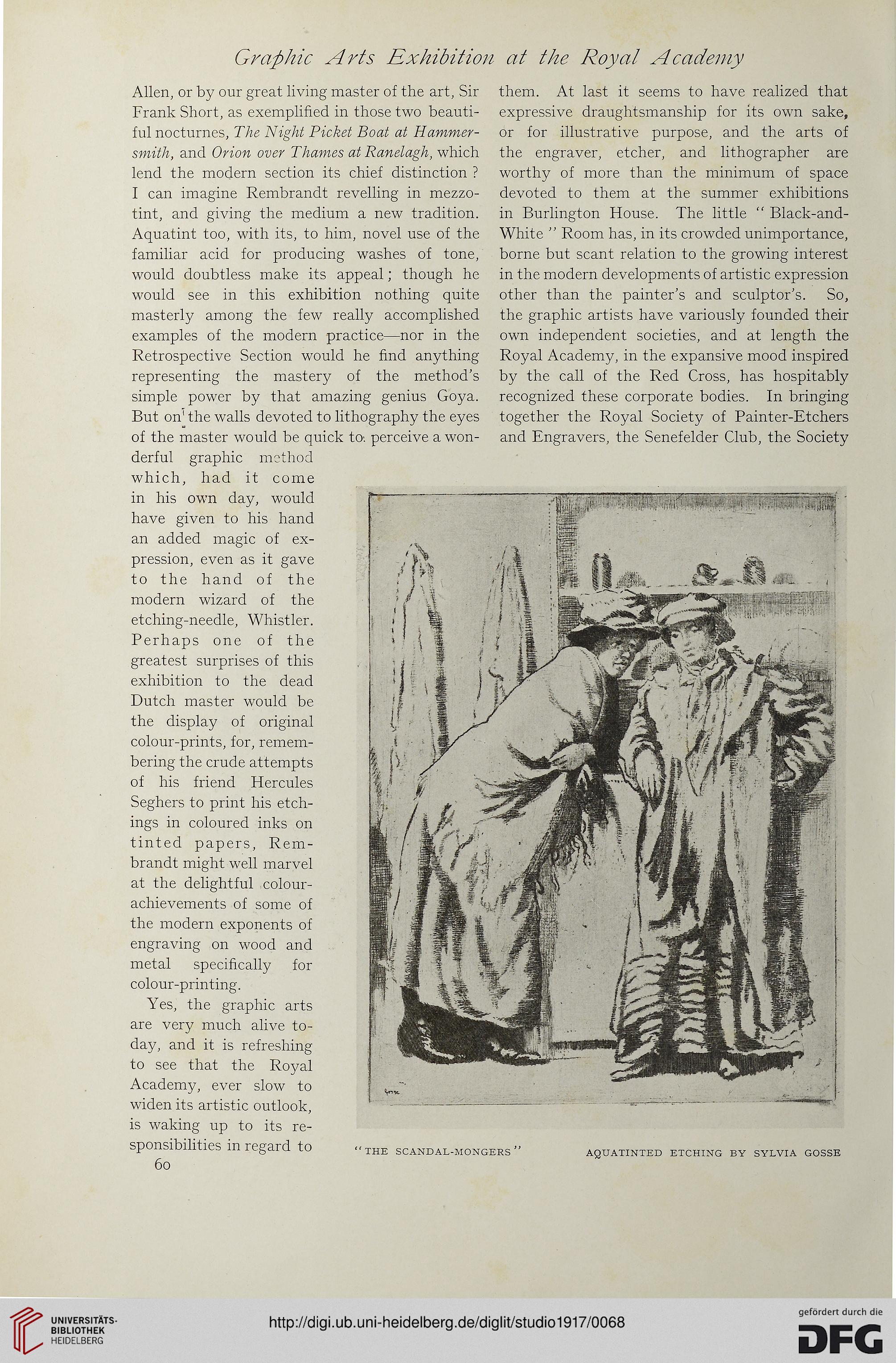Graphic Arts Exhibition at the Roy at Academy
Allen, or by our great living master of the art, Sir
Frank Short, as exemplified in those two beauti-
ful nocturnes, The Night Picket Boat at Hammer-
smith, and Orion over Thames at Ranelagh, which
lend the modern section its chief distinction ?
I can imagine Rembrandt revelling in mezzo-
tint, and giving the medium a new tradition.
Aquatint too, with its, to him, novel use of the
familiar acid for producing washes of tone,
would doubtless make its appeal; though he
would see in this exhibition nothing quite
masterly among the few really accomplished
examples of the modern practice—nor in the
Retrospective Section would he find anything
representing the mastery of the method’s
simple power by that amazing genius Goya.
But on1 the walls devoted to lithography the eyes
of the master would be quick to1, perceive a won-
derful graphic method
which, had it come
in his own day, would
have given to his hand
an added magic of ex-
pression, even as it gave
to the hand of the
modern wizard of the
etching-needle, Whistler.
Perhaps one of the
greatest surprises of this
exhibition to the dead
Dutch master would be
the display of original
colour-prints, for, remem-
bering the crude attempts
of his friend Flercules
Seghers to print his etch-
ings in coloured inks on
tinted papers, Rem-
brandt might well marvel
at the delightful colour-
achievements of some of
the modern exponents of
engraving on wood and
metal specifically for
colour-printing.
Yes, the graphic arts
are very much alive to-
day, and it is refreshing
to see that the Royal
Academy, ever slow to
widen its artistic outlook,
is waking up to its re-
sponsibilities in regard to
60
them. At last it seems to have realized that
expressive draughtsmanship for its own sake,
or for illustrative purpose, and the arts of
the engraver, etcher, and lithographer are
worthy of more than the minimum of space
devoted to them at the summer exhibitions
in Burlington House. The little “ Black-and-
White ” Room has, in its crowded unimportance,
borne but scant relation to the growing interest
in the modern developments of artistic expression
other than the painter’s and sculptor’s. So,
the graphic artists have variously founded their
own independent societies, and at length the
Royal Academy, in the expansive mood inspired
by the call of the Red Cross, has hospitably
recognized these corporate bodies. In bringing
together the Royal Society of Painter-Etchers
and Engravers, the Senefelder Club, the Society
THE SCANDAL-MONGERS” AQUATINTED ETCHING BY SYLVIA GOSSE
Allen, or by our great living master of the art, Sir
Frank Short, as exemplified in those two beauti-
ful nocturnes, The Night Picket Boat at Hammer-
smith, and Orion over Thames at Ranelagh, which
lend the modern section its chief distinction ?
I can imagine Rembrandt revelling in mezzo-
tint, and giving the medium a new tradition.
Aquatint too, with its, to him, novel use of the
familiar acid for producing washes of tone,
would doubtless make its appeal; though he
would see in this exhibition nothing quite
masterly among the few really accomplished
examples of the modern practice—nor in the
Retrospective Section would he find anything
representing the mastery of the method’s
simple power by that amazing genius Goya.
But on1 the walls devoted to lithography the eyes
of the master would be quick to1, perceive a won-
derful graphic method
which, had it come
in his own day, would
have given to his hand
an added magic of ex-
pression, even as it gave
to the hand of the
modern wizard of the
etching-needle, Whistler.
Perhaps one of the
greatest surprises of this
exhibition to the dead
Dutch master would be
the display of original
colour-prints, for, remem-
bering the crude attempts
of his friend Flercules
Seghers to print his etch-
ings in coloured inks on
tinted papers, Rem-
brandt might well marvel
at the delightful colour-
achievements of some of
the modern exponents of
engraving on wood and
metal specifically for
colour-printing.
Yes, the graphic arts
are very much alive to-
day, and it is refreshing
to see that the Royal
Academy, ever slow to
widen its artistic outlook,
is waking up to its re-
sponsibilities in regard to
60
them. At last it seems to have realized that
expressive draughtsmanship for its own sake,
or for illustrative purpose, and the arts of
the engraver, etcher, and lithographer are
worthy of more than the minimum of space
devoted to them at the summer exhibitions
in Burlington House. The little “ Black-and-
White ” Room has, in its crowded unimportance,
borne but scant relation to the growing interest
in the modern developments of artistic expression
other than the painter’s and sculptor’s. So,
the graphic artists have variously founded their
own independent societies, and at length the
Royal Academy, in the expansive mood inspired
by the call of the Red Cross, has hospitably
recognized these corporate bodies. In bringing
together the Royal Society of Painter-Etchers
and Engravers, the Senefelder Club, the Society
THE SCANDAL-MONGERS” AQUATINTED ETCHING BY SYLVIA GOSSE




